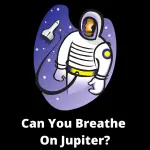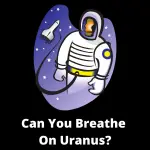No, humans cannot breathe on Saturn.
In the article that follows, we’ll explain.
Can You Breathe On Saturn? (EXPLAINED)
Relevant Facts About Saturn
Saturn is the 6th planet in our solar system, and is arguably one of the best known planets in our solar system after Earth.
It’s distinctive rings make it easy to identify.
Like Jupiter, Saturn is a gas giant, composed primarily of hydrogen and helium, with some methane and water ice.
There is no surface of the planet to stand on or land on, though deep inside the planet, the pressure probably compresses the gases into a solid core.
Around the gas planet, there are layers of clouds.
The outer layer is made of ammonia.
The cloud layer below that is made of ammonium hydrosulphide.
Under that, the clouds are water clouds.
Under that, the composition of the atmosphere is really similar to that of the planet itself.
The transition between the planet’s atmosphere and the gas planet is not exactly clear.
But to our knowledge, there is little (if any) oxygen in the clouds of any layer, between the clouds and the planet, or in the planet itself.
The atmospheric pressure around where we estimate the surface of Saturn to be is similar to that of Earth (unlike the air pressure on the surface of Venus which is crushingly strong).
The gravity near the surface of Saturn is also similar to Earth’s, though slightly more.
Relevant Facts About Human Respiration
The gas/air humans breathe here on Earth is composed of about 21% oxygen.
The rest is mostly nitrogen, with trace amounts of other gases, such as carbon dioxide, argon, krypton and others.
The amount of oxygen in the atmosphere of Earth is the right amount of human survival.
If the amount of oxygen in the air that we breathe is less than we are used to, we may feel faint, dizzy, loose consciousness, or even die.
If there is too much oxygen in the air that we breathe, humans can suffer permanent damage to the nervous system and other delicate tissues.
But in the end, what we breathe has to have oxygen in it for our survival.
Why Can’t Humans Breathe On Saturn?
The primary reason humans can’t breathe on Saturn is that there is little to no oxygen in, on, or around the planet.
Let’s put aside all the questions of whether other aspects of the planet would kill you, such as radiation, or high winds, or heat, or cold.
If you were to try and breathe the atmosphere around Saturn, you’d die.
Close to the surface of the planet (wherever that exactly is), the “air” or gas that would be available to breathe is hydrogen and helium with traces of other gases.
Further away from the planet, the hydrogen/helium are not as dense, but still the only thing you can breathe.
If you get far enough away to get into the cloud layers, there’s still not significant breathable oxygen, and probably some substances which we wouldn’t want to breathe (the ammonia clouds would be particularly bad for us).
But again, remember that there are other physical challenges posed by Saturn. Even if you wanted to try and breathe the air in the upper reaches of the Saturn atmosphere, it would be too cold to breathe, and trying to breathe is at that temperature would also probably cause mortal damage.
There’s also the issue of the winds on Saturn, which can exceed 1,000 miles per hour.
A human probably wouldn’t be able to breathe in winds of 1,000 miles per hour (or would the ship be able to navigate you to place where you could try to breathe Saturn’s atmosphere).
The gravity and atmospheric pressure are non-issues on this question, as they are pretty similar to that which we enjoy here on Earth.
Finally, while its a small point, we really can’t breathe on Saturn.
We can’t land on Saturn, or walk on Saturn, or otherwise in any shape or form do anything on Saturn.
Thus, as the question is phrased, it is pretty easy to answer the question with a solid “no.”
Did You Know? (Other Facts About Saturn)
Here are some facts you may not have known about Saturn:
- More than 700 Earths could fit inside Saturn. But while it is huge, it is the least dense of all the planets. In fact, it’s density is less than that of water. This is the reason people like to say that Saturn could float.
- Saturn is visible from Earth with the naked eye. It is the furthest planet from Earth that we can observe without a telescope. If we wanted to see Uranus or Neptune, we’d have to use some sort of magnification device to assist us.
- Saturn’s distinctive rings are really wide. The width of Saturn’s rings is pretty close to the distance between the Earth and the Earth’s moon, about 175,000 miles. However, even though these rings are wide, they are not thick at all. In fact, some scientists estimate that the rings are only between 30-100 feet thick. Others estimate that the rings are closer to 3200 feet thick. While this is a huge discrepancy in size, either way, everyone agrees that the rings are thin.
- Like Jupiter, Saturn spins really quickly. It takes about 10 Earth hours to rotate on its axis fully one time.
- While Saturn is not considered habitable, several of Saturn’s moons are being investigated as possibly being able to support human habitation.
Wrap Up
Saturn is a fascinating planet, and we look forward to learning more about it as the progress of space exploration continues.
You might also enjoy:







